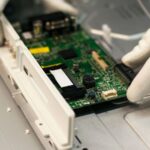(Originally posted on Oct 5, 2018 on the Drishti blog)
In the mid-1990s, I led the industry/academia team at General Motors that built the world’s first collaborative robots. It was hard work; most people even in robotics had not heard of a “cobot” (or, “intelligent assist devices” (IADs) as we referred to the broader category), knew what it was, much less how it could be useful. Our academic partners-in-crime, Northwestern Professors Michael Peshkin and Ed Colgate, founded Cobotics, Inc. (renamed CoMoCo, for Collaborative Motion Control, Inc.), the first startup in the cobot market, in 1996 while UC Berkeley Professor Hami Kazerooni went on to found Berkeley Bionics, renamed Ekso Bionics, later on). By the time I left to head back to the Valley and co-found the social networking pioneer Spoke Software, the word was out. Vendors like Fanuc, ABB, Gorbel and Stanley were producing early versions of product, and companies, including GM and Ford, were beginning to explore the use of cobots of different forms because they could see how useful and valuable this form of collaborative automation was on the factory floor.
Fast forward a decade, and Esben Østergaard, Kasper Støy and Kristian Kassow founded Universal Robotics in 2007, while Rodney Brooks and Ann Whittaker launched Rethink Robotics (then Heartland Robotics) in 2008 – and all previous cobot development efforts paled in comparison. Brooks’ track record and dynamism leant a celebrity power to his company. It’s indisputable how much Baxter and its little brother, Sawyer, changed the landscape and public dialogue around collaborative robots over the next ten years.
That’s what makes this week’s news about Rethink Robotics closing its doors such a shame, but it doesn’t come as a surprise. As I learned first-hand at Spoke, and as anyone who has worked in the startup world knows, it’s a hard road. And even after many successful years, companies can fail. Especially when you’re trying to define a category – to prove the value of a technology that has yet to be seen by the vast majority of your audience – the roadblocks are many, and the folks who emerge as victors are few.
Still, there are several takeaways we in the world of manufacturing automation can glean from Rethink’s journey, and use to help drive our own successes to the benefit of everyone in the factory:
- Humans still run the show, and will for a long time: Despite the benefits that robots can bring to a factory floor, 90 percent of tasks are still done by humans. Machines simply don’t have the dexterity, cognition or adaptability to manage those tasks. And that means manufacturers still need people and have a blindspot when it comes to operations and data, unless they can find a better way to measure actions performed by humans. The need for cobots and IADs persists.
- Augmenting and digitizing human tasks is key, but squarely in Industry 4.0’s blind spot: Because humans will continue to be an important element of the factory floor for the foreseeable future, true digital transformation relies on helping humans complete tasks better and more efficiently. Whether that comes in the form of cobots (like Rethink) or other emerging technology like computer vision, AI and machine learning, manufacturing technology can’t ignore the human element, and instead must be built on the premise of man AND machine working together, not robots replacing humans.
- Demand for new ideas in manufacturing is still high: As the reaction to Rethink’s exit demonstrates, after four decades of manufacturing’s nuclear winter, the manufacturing community is eager for fresh ideas and innovative thinking in the manufacturing realm. Companies who push the boundaries of what’s possible and drive more in terms of productivity, quality and traceability in the industry are in high demand. New companies, like Drishti, are taking up the yoke of creativity and empowering manufacturers to better understand what’s happening on the factory floor – including the tasks that humans do.
- There’s an ever-present need for startups to be focused on solving real (manufacturing) problems: As I look back in cobot time and compare that with where we are in the world of AI, Frank Chen’s notion of “narrow AI” resonates. The simple thought is that when you are creating a new technology, you want to pick the vectors that promise to have clear and measurable impact on your customers while solving the most critical problems. And, by solving these often narrowly defined problems, you build a revenue path ahead of you. Viewing Rethink’s products from afar, I always wondered if they traded off generalizability and stiffness for ease of programming and a human-friendly appearance. A point was often made by early adopters who were concerned that they couldn’t accurately position the end effector, even with a relatively small payload, because compliance was introduced into the arm to make it human-safe. Leaving the core task of a cobot – of safely and precisely carrying payloads around – compromised. While the better-versed folks can comment on this hypothesis, what continues to be clear to me is that one has to solve clear and financially impactful problems to be viable.
It’s never a happy occasion to see a promising company with pioneering technology fail, especially one where a very dedicated and smart set of people have worked so hard. Luckily, Rethink’s end doesn’t mean the end of innovation in manufacturing, and I look forward to an exciting future for all of stripes of Industry 4.0 startups (including Drishti) that are attempting to help companies harness and evaluate data from tasks their machines and employees execute on the floor. The potential to impact GDP and human lives is incredible.
Our thanks and best wishes go to the pioneering team at Rethink, whom I personally applaud for moving the world of cobots forward.
Read how Drishti can help your factory workers be more competitive in a global landscape.










